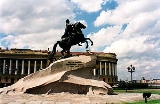
The Bronze Horseman
Encyclopedia

Peter I of Russia
Peter the Great, Peter I or Pyotr Alexeyevich Romanov Dates indicated by the letters "O.S." are Old Style. All other dates in this article are New Style. ruled the Tsardom of Russia and later the Russian Empire from until his death, jointly ruling before 1696 with his half-brother, Ivan V...
in Saint Petersburg
Saint Petersburg
Saint Petersburg is a city and a federal subject of Russia located on the Neva River at the head of the Gulf of Finland on the Baltic Sea...
, Russia
Russia
Russia or , officially known as both Russia and the Russian Federation , is a country in northern Eurasia. It is a federal semi-presidential republic, comprising 83 federal subjects...
. Commissioned by Catherine the Great
Catherine II of Russia
Catherine II, also known as Catherine the Great , Empress of Russia, was born in Stettin, Pomerania, Prussia on as Sophie Friederike Auguste von Anhalt-Zerbst-Dornburg...
, it was created by the French sculptor Étienne Maurice Falconet
Étienne Maurice Falconet
Étienne Maurice Falconet is counted among the first rank of French Rococo sculptors, whose patron was Mme de Pompadour.-Life:Falconet was born to a poor family in Paris...
. It is also the name of a narrative poem
The Bronze Horseman (poem)
The Bronze Horseman: A Petersburg Tale is a narrative poem written by Aleksandr Pushkin in 1833 about the equestrian statue of Peter the Great in Saint Petersburg. Widely considered to be Pushkin's most successful narrative poem, "The Bronze Horseman" has had a lasting impact on Russian...
written by Aleksandr Pushkin
Aleksandr Pushkin
Alexander Sergeyevich Pushkin was a Russian author of the Romantic era who is considered by many to be the greatest Russian poet and the founder of modern Russian literature....
about the statue in 1833
1833 in poetry
Nationality words link to articles with information on the nation's poetry or literature .-Events:* Arthur Henry Hallam, a friend of Alfred, Lord Tennyson, dies suddenly of a stroke in Vienna...
, widely considered to be one of the most significant works of Russian literature
Russian literature
Russian literature refers to the literature of Russia or its émigrés, and to the Russian-language literature of several independent nations once a part of what was historically Russia or the Soviet Union...
. The statue came to be known as the Bronze Horseman because of the great influence of the poem. The statue is now one of the symbols of Saint Petersburg, in much the same way that the Statue of Liberty
Statue of Liberty
The Statue of Liberty is a colossal neoclassical sculpture on Liberty Island in New York Harbor, designed by Frédéric Bartholdi and dedicated on October 28, 1886...
is a symbol of New York City
New York City
New York is the most populous city in the United States and the center of the New York Metropolitan Area, one of the most populous metropolitan areas in the world. New York exerts a significant impact upon global commerce, finance, media, art, fashion, research, technology, education, and...
. Both of them were designed and built by French
France
The French Republic , The French Republic , The French Republic , (commonly known as France , is a unitary semi-presidential republic in Western Europe with several overseas territories and islands located on other continents and in the Indian, Pacific, and Atlantic oceans. Metropolitan France...
artists.
The statue's pedestal
Pedestal
Pedestal is a term generally applied to the support of a statue or a vase....
is the enormous Thunder Stone, claimed to be the largest stone ever moved by man (1,250 t
Tonne
The tonne, known as the metric ton in the US , often put pleonastically as "metric tonne" to avoid confusion with ton, is a metric system unit of mass equal to 1000 kilograms. The tonne is not an International System of Units unit, but is accepted for use with the SI...
). The initial stone was about 2000 tonnes and was carved during its transit to the current site.
Statue

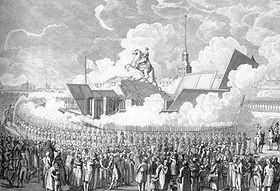
Peter I of Russia
Peter the Great, Peter I or Pyotr Alexeyevich Romanov Dates indicated by the letters "O.S." are Old Style. All other dates in this article are New Style. ruled the Tsardom of Russia and later the Russian Empire from until his death, jointly ruling before 1696 with his half-brother, Ivan V...
is situated in the Senate Square (formerly the Decembrists Square
Decembrists Square
Senate Square , formerly known as Decembrists' Square in 1925-2008, and Peter's Square , before 1925, is a city square in Saint Petersburg, Russia. It is situated on the left bank of the Bolshaya Neva, in front of Saint Isaac's Cathedral...
), in Saint Petersburg
Saint Petersburg
Saint Petersburg is a city and a federal subject of Russia located on the Neva River at the head of the Gulf of Finland on the Baltic Sea...
. Catherine the Great
Catherine II of Russia
Catherine II, also known as Catherine the Great , Empress of Russia, was born in Stettin, Pomerania, Prussia on as Sophie Friederike Auguste von Anhalt-Zerbst-Dornburg...
, a German
Germany
Germany , officially the Federal Republic of Germany , is a federal parliamentary republic in Europe. The country consists of 16 states while the capital and largest city is Berlin. Germany covers an area of 357,021 km2 and has a largely temperate seasonal climate...
princess who married into the Romanov
Romanov
The House of Romanov was the second and last imperial dynasty to rule over Russia, reigning from 1613 until the February Revolution abolished the crown in 1917...
line, was anxious to connect herself to Peter the Great to gain legitimacy in the eyes of the people. She ordered its construction, and had it inscribed with the phrase Petro Primo Catharina Secunda MDCCLXXXII in Latin
Latin
Latin is an Italic language originally spoken in Latium and Ancient Rome. It, along with most European languages, is a descendant of the ancient Proto-Indo-European language. Although it is considered a dead language, a number of scholars and members of the Christian clergy speak it fluently, and...
and Петру перьвому Екатерина вторая, лѣта 1782 in Russian, both meaning 'Catherine the Second to Peter the First, 1782', an expression of her admiration toward her predecessor and her view of her own place in the line of great Russian rulers. Having gained her position through a palace coup, Catherine had no legal claim to the throne and wanted to represent herself as Peter's rightful heir.
In correspondence with Catherine the Great
Catherine II of Russia
Catherine II, also known as Catherine the Great , Empress of Russia, was born in Stettin, Pomerania, Prussia on as Sophie Friederike Auguste von Anhalt-Zerbst-Dornburg...
, Denis Diderot
Denis Diderot
Denis Diderot was a French philosopher, art critic, and writer. He was a prominent person during the Enlightenment and is best known for serving as co-founder and chief editor of and contributor to the Encyclopédie....
suggested French
France
The French Republic , The French Republic , The French Republic , (commonly known as France , is a unitary semi-presidential republic in Western Europe with several overseas territories and islands located on other continents and in the Indian, Pacific, and Atlantic oceans. Metropolitan France...
sculptor Étienne Maurice Falconet
Étienne Maurice Falconet
Étienne Maurice Falconet is counted among the first rank of French Rococo sculptors, whose patron was Mme de Pompadour.-Life:Falconet was born to a poor family in Paris...
, a friend of his, for the commission. The empress followed his advice, and Falconet arrived in Russia in 1766.
In 1775 the casting of the statue began, supervised by caster Emelyan Khailov. At one point during the casting, the mould
Molding (process)
Molding or moulding is the process of manufacturing by shaping pliable raw material using a rigid frame or model called a pattern....
broke, releasing molten bronze that started several fires. All the workers ran except Khailov, who risked his life to salvage the casting. After having to be remelted and recast, the statue was later finished. It took 12 years, from 1770 to 1782, to create the statue, including pedestal
Pedestal
Pedestal is a term generally applied to the support of a statue or a vase....
, horse and rider.
The tsar
Tsar
Tsar is a title used to designate certain European Slavic monarchs or supreme rulers. As a system of government in the Tsardom of Russia and Russian Empire, it is known as Tsarist autocracy, or Tsarism...
's face is the work of the young Marie-Anne Collot, then only 18 years old. She had accompanied Falconet as an apprentice on his trip to Russia
Russia
Russia or , officially known as both Russia and the Russian Federation , is a country in northern Eurasia. It is a federal semi-presidential republic, comprising 83 federal subjects...
in 1766. A student of Falconet and Jean-Baptiste Lemoyne
Jean-Baptiste Lemoyne
Jean-Baptiste Lemoyne was a French sculptor, among the greatest French portraitists. He was the pupil of his father, Jean-Louis Lemoyne, and of Robert Le Lorrain....
, Collot was called Mademoiselle Victoire (Miss Victory) by Diderot. She modelled Peter the Great's face after his death mask
Death mask
In Western cultures a death mask is a wax or plaster cast made of a person’s face following death. Death masks may be mementos of the dead, or be used for creation of portraits...
and numerous portraits she found in Saint Petersburg. The right hand of the statue was modelled from a Roman bronze hand, found in 1771 in Voorburg
Voorburg
Voorburg is a Dutch town and former municipality in the western part of the province of South Holland, the Netherlands. As also Leidschendam and Stompwijk, it is part of the municipality Leidschendam-Voorburg. It has approximately 39,000 inhabitants....
, The Netherlands at the site of the ancient Roman town Forum Hadriani
Forum Hadriani
Forum Hadriani, at the modern town of Voorburg, was the northern-most Roman city on the European continent and the second oldest city of The Netherlands. It was located in the Roman province Germania Inferior and is mentioned on the Tabula Peutingeriana, a Roman road map.The site Forum Hadriani...
.
On August 9, 1782, fourteen years after excavation of the pedestal began, the finished statue was unveiled in a ceremony with thousands in attendance. Conspicuously absent was Falconet, as a misunderstanding between him and the empress turned into a larger conflict, and he was forced to leave Russia four years before the project was completed. Catherine largely forgot about him afterwards, and began to see the Bronze Horseman as her own oeuvre.
The statue portrays Peter the Great sitting heroically on his horse, his outstretched arm pointing towards the River Neva in the west. The sculptor wished to capture the exact moment of his horse rearing at the edge of a dramatic cliff. His horse can be seen trampling a serpent
Serpent (symbolism)
Serpent in Latin means: Rory Collins :&, in turn, from the Biblical Hebrew word of: "saraf" with root letters of: which refers to something burning-as, the pain of poisonous snake's bite was likened to internal burning.This word is commonly used in a specifically mythic or religious context,...
, variously interpreted to represent treachery, evil or the enemies of Peter and his reforms. The statue itself is about 6 m (20 feet) tall, while the pedestal is another 7 m (25 feet) tall, for a total of approximately 13 m (45 feet).
Thunder Stone
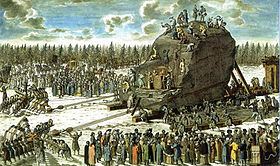
Boulder
In geology, a boulder is a rock with grain size of usually no less than 256 mm diameter. While a boulder may be small enough to move or roll manually, others are extremely massive....
known as the Thunder Stone (Russian: Камень-Гром) was found at Lakhta
Lakhta, Saint Petersburg
Lakhta is a historical area in Lakhta-Olgino Municipal Okrug of St. Petersburg, Russia, situated west of Lake Lakhta . It was formerly owned by Peter the Great, Count Grigory Orlov, and Count Stenbock-Fermor . The Lakhta railway station of the Primorsky Railway connects Lakhta to Central...
, 6 km (3.7 mi) inland from the Gulf of Finland
Gulf of Finland
The Gulf of Finland is the easternmost arm of the Baltic Sea. It extends between Finland and Estonia all the way to Saint Petersburg in Russia, where the river Neva drains into it. Other major cities around the gulf include Helsinki and Tallinn...
in 1768. The Thunder Stone gained its name from a local legend that thunder
Thunder
Thunder is the sound made by lightning. Depending on the nature of the lightning and distance of the listener, thunder can range from a sharp, loud crack to a long, low rumble . The sudden increase in pressure and temperature from lightning produces rapid expansion of the air surrounding and within...
split a piece off it. Falconet wanted to work on shaping the stone in its original location, but Catherine ordered it be moved before being cut. As it was embedded half its depth and the area was marshy terrain, the Russians had to develop new methods to dig up and transport the colossal stone. Marinos Carburis (Μαρίνος Χαρμπούρης), a Greek from the Island of Kefallonia and serving as lieutenant-colonel in the Russian Army
Imperial Russian Army
The Imperial Russian Army was the land armed force of the Russian Empire, active from around 1721 to the Russian Revolution of 1917. In the early 1850s, the Russian army consisted of around 938,731 regular soldiers and 245,850 irregulars . Until the time of military reform of Dmitry Milyutin in...
, offered to undertake the project. Carburis had studied engineering in Vienna
Vienna
Vienna is the capital and largest city of the Republic of Austria and one of the nine states of Austria. Vienna is Austria's primary city, with a population of about 1.723 million , and is by far the largest city in Austria, as well as its cultural, economic, and political centre...
and is considered to be the first Greek to hold a diploma in engineering.
Carburis directed workmen to wait for winter, when the ground was frozen, and then had them drag the large stone over the frozen ground to the sea for shipment and transport to the city. He developed a metallic sledge that slid over bronze
Bronze
Bronze is a metal alloy consisting primarily of copper, usually with tin as the main additive. It is hard and brittle, and it was particularly significant in antiquity, so much so that the Bronze Age was named after the metal...
spheres about 13.5 cm (6 inches) in diameter, over a track. The process worked in a way similar to the later invention of ball bearings. Making the feat even more impressive was that the labour was done entirely by humans; no animals or machines were used in bringing the stone from the original site to the Senate Square. After Carburis devised the method, it took 400 men nine months to move the stone, during which time master stonecutters
Stonemasonry
The craft of stonemasonry has existed since the dawn of civilization - creating buildings, structures, and sculpture using stone from the earth. These materials have been used to construct many of the long-lasting, ancient monuments, artifacts, cathedrals, and cities in a wide variety of cultures...
continuously shaped the enormous granite
Granite
Granite is a common and widely occurring type of intrusive, felsic, igneous rock. Granite usually has a medium- to coarse-grained texture. Occasionally some individual crystals are larger than the groundmass, in which case the texture is known as porphyritic. A granitic rock with a porphyritic...
monolith. Catherine periodically visited the effort to oversee their progress. The larger capstans
Capstan (nautical)
A capstan is a vertical-axled rotating machine developed for use on sailing ships to apply force to ropes, cables, and hawsers. The principle is similar to that of the windlass, which has a horizontal axle.- History :...
took 32 men at once to turn, this just barely moving the rock. Further complicating the issue was the availability of only 100 m of track, which had to be constantly disassembled and relaid. Nevertheless, the workers made over 150 m of progress a day while on level ground. Upon arrival at the sea an enormous barge was constructed exclusively for the Thunder Stone. The vessel had to be supported on either side by additional two full-size warships. After a short maritime voyage, the stone reached its destination in 1770, after nearly two years of work. A commemorative medal
Medal
A medal, or medallion, is generally a circular object that has been sculpted, molded, cast, struck, stamped, or some way rendered with an insignia, portrait, or other artistic rendering. A medal may be awarded to a person or organization as a form of recognition for athletic, military, scientific,...
was issued for its arrival, with the legend "Close to Daring".
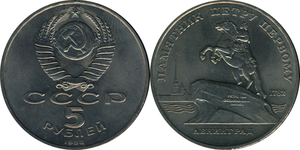
The "largest stone ever moved by man"
The Thunder Stone is sometimes claimed to be the "largest stone ever moved by man". This stone was large and heavy; it was effectively moved 6 km (3.7 mi) overland to the Gulf of FinlandGulf of Finland
The Gulf of Finland is the easternmost arm of the Baltic Sea. It extends between Finland and Estonia all the way to Saint Petersburg in Russia, where the river Neva drains into it. Other major cities around the gulf include Helsinki and Tallinn...
by manpower alone; no animals or machines were used. Transported by barge up the Neva River
Neva River
The Neva is a river in northwestern Russia flowing from Lake Ladoga through the western part of Leningrad Oblast to the Neva Bay of the Gulf of Finland. Despite its modest length , it is the third largest river in Europe in terms of average discharge .The Neva is the only river flowing from Lake...
, it reached St. Petersburg. The entire effort is considered an historic engineering feat.
Due to the large size of the rock, the easiest way to measure its mass is to calculate it. According to the fall 1882 edition of La Nature
La Nature
La Nature was a French language magazine aimed at the popularization of science founded in 1873 by French scientist and adventurer Gaston Tissandier...
, its dimensions before being cut were 7 × 14 × 9 m. Based on the density
Density
The mass density or density of a material is defined as its mass per unit volume. The symbol most often used for density is ρ . In some cases , density is also defined as its weight per unit volume; although, this quantity is more properly called specific weight...
of granite
Granite
Granite is a common and widely occurring type of intrusive, felsic, igneous rock. Granite usually has a medium- to coarse-grained texture. Occasionally some individual crystals are larger than the groundmass, in which case the texture is known as porphyritic. A granitic rock with a porphyritic...
, its mass
Mass
Mass can be defined as a quantitive measure of the resistance an object has to change in its velocity.In physics, mass commonly refers to any of the following three properties of matter, which have been shown experimentally to be equivalent:...
was determined to be around 1500 tonne
Tonne
The tonne, known as the metric ton in the US , often put pleonastically as "metric tonne" to avoid confusion with ton, is a metric system unit of mass equal to 1000 kilograms. The tonne is not an International System of Units unit, but is accepted for use with the SI...
s. Falconet had some of this cut away to make a wave-like shape, so the finished pedestal weighed slightly less. It is still the largest when compared to other large, sculpted stones:
- The unfinished obeliskUnfinished obeliskThe unfinished obelisk is the largest known ancient obelisk, located in the northern region of the stone quarries of ancient Egypt in Aswan , Egypt. It is unknown which pharaoh created this structure. It is nearly one third larger than any ancient Egyptian obelisk ever erected...
in AswanAswanAswan , formerly spelled Assuan, is a city in the south of Egypt, the capital of the Aswan Governorate.It stands on the east bank of the Nile at the first cataract and is a busy market and tourist centre...
is estimated at 1200 tonnes. It was not ever moved, and was never detached from the rock from which it was being carved. 1200 tonnes is less than the initial calculated mass of the Thunder Stone. - The Roman Stone of the Pregnant WomanStone of the Pregnant WomanThe Stone of the Pregnant Woman or Stone of the South is a Roman monolith in Baalbek , Lebanon. Together with another ancient stone block nearby, it is among the very largest monoliths ever quarried by men...
in BaalbekBaalbekBaalbek is a town in the Beqaa Valley of Lebanon, altitude , situated east of the Litani River. It is famous for its exquisitely detailed yet monumentally scaled temple ruins of the Roman period, when Baalbek, then known as Heliopolis, was one of the largest sanctuaries in the Empire...
is measured at around 20.5 m × 4–5.3 m × 4.2 m high, putting its mass at ca. 1,000 t. It was removed from its quarry, but sits on an angle not far from the site of its extraction. It has less than the initial mass of the Thunder Stone. - The Western StoneWestern StoneThe Western Stone, located in the northern section of Wilson's Arch, is a monolithic stone block forming part of the lower level of the Western Wall in Jerusalem. Weighing 517 tonnes , it is one of the largest building blocks in the world. The stone is 13.6 meters long and 3 metres high and has...
is estimated at 517 tonnes; it was moved as a single piece and was used as a foundation stone in the northern corner of the Western WallWestern WallThe Western Wall, Wailing Wall or Kotel is located in the Old City of Jerusalem at the foot of the western side of the Temple Mount...
in Jerusalem. The wall was constructed around 20 BC. - The Great Broken Menhir of LocmariaquerLocmariaquerLocmariaquer is a commune in the Morbihan department in Brittany in north-western France.It lies south of Auray by road.-Coat of arms:This coat of arms was created 30 years ago by the local artist Jean-Baptiste Corlobé...
, now in five pieces, was 20 m tall and likely weighed over 300 tonnes. - The obeliskObeliskAn obelisk is a tall, four-sided, narrow tapering monument which ends in a pyramid-like shape at the top, and is said to resemble a petrified ray of the sun-disk. A pair of obelisks usually stood in front of a pylon...
at the Basilica of St. John LateranBasilica of St. John LateranThe Papal Archbasilica of St. John Lateran , commonly known as St. John Lateran's Archbasilica and St. John Lateran's Basilica, is the cathedral of the Diocese of Rome and the official ecclesiastical seat of the Bishop of Rome, who is the Pope...
was broken into three pieces. After being transported to RomeRomeRome is the capital of Italy and the country's largest and most populated city and comune, with over 2.7 million residents in . The city is located in the central-western portion of the Italian Peninsula, on the Tiber River within the Lazio region of Italy.Rome's history spans two and a half...
, the pieces were put together and secured, as ordered by Pope Sixtus VPope Sixtus VPope Sixtus V , born Felice Peretti di Montalto, was Pope from 1585 to 1590.-Early life:The chronicler Andrija Zmajević states that Felice's family originated from modern-day Montenegro...
. At 32 m tall, it probably weighs more than 350 tonnes. - The Great Stele at AxumAxumAxum or Aksum is a city in northern Ethiopia which was the original capital of the eponymous kingdom of Axum. Population 56,500 . Axum was a naval and trading power that ruled the region from ca. 400 BC into the 10th century...
is estimated to have weighed over 500 tonnes. It was moved from its quarry, but is believed to have broken while being erected.
Siege of Leningrad
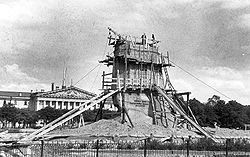
Siege of Leningrad
The Siege of Leningrad, also known as the Leningrad Blockade was a prolonged military operation resulting from the failure of the German Army Group North to capture Leningrad, now known as Saint Petersburg, in the Eastern Front theatre of World War II. It started on 8 September 1941, when the last...
by the invading Germans during the Second World War
World War II
World War II, or the Second World War , was a global conflict lasting from 1939 to 1945, involving most of the world's nations—including all of the great powers—eventually forming two opposing military alliances: the Allies and the Axis...
(Leningrad being the city's name from 1924–1991), the statue was not taken down, but covered with sandbags and a wooden shelter. The protection served so well that the Bronze Horseman survived the 900 days of bombing and artillery virtually untouched. True to legend, Leningrad was never taken.
Poem
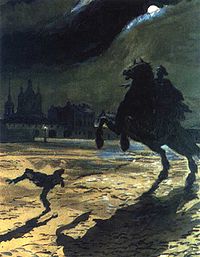
Aleksandr Pushkin
Alexander Sergeyevich Pushkin was a Russian author of the Romantic era who is considered by many to be the greatest Russian poet and the founder of modern Russian literature....
in 1833
1833 in poetry
Nationality words link to articles with information on the nation's poetry or literature .-Events:* Arthur Henry Hallam, a friend of Alfred, Lord Tennyson, dies suddenly of a stroke in Vienna...
, widely considered to be one of the most significant works of Russian literature
Russian literature
Russian literature refers to the literature of Russia or its émigrés, and to the Russian-language literature of several independent nations once a part of what was historically Russia or the Soviet Union...
. Due to the popularity of his work, the statue came to be called the "Bronze Horseman". A major theme of the poem is conflict between the needs of the state and the needs of the ordinary citizens.
In the poem, Pushkin describes the fates of the poor man Evgenii and his beloved Parasha during a severe flood
Floods in Saint Petersburg
Floods in Saint Petersburg refer to a rise of water on the territory of St. Petersburg, a major city in Russia and its former capital. They are usually caused by the overflow of the delta of Neva River and surging water in the eastern part of Neva Bay but sometimes caused by melting snow...
of the Neva
Neva River
The Neva is a river in northwestern Russia flowing from Lake Ladoga through the western part of Leningrad Oblast to the Neva Bay of the Gulf of Finland. Despite its modest length , it is the third largest river in Europe in terms of average discharge .The Neva is the only river flowing from Lake...
. Evgenii curses the statue, furious at Peter the Great
Peter I of Russia
Peter the Great, Peter I or Pyotr Alexeyevich Romanov Dates indicated by the letters "O.S." are Old Style. All other dates in this article are New Style. ruled the Tsardom of Russia and later the Russian Empire from until his death, jointly ruling before 1696 with his half-brother, Ivan V...
for founding a city in such an unsuitable location and indirectly causing the death of his beloved. Coming to life, the horseman chases Evgenii through the city. The poem closes with the discovery of the young man's corpse in a ruined hut floating at the edge of the river.
In 1903 the artist Alexandre Benois
Alexandre Benois
Alexandre Nikolayevich Benois , an influential artist, art critic, historian, preservationist, and founding member of Mir iskusstva , an art movement and magazine...
published an edition of the poem with his illustrations, creating what was considered a masterwork of Art Nouveau
Art Nouveau
Art Nouveau is an international philosophy and style of art, architecture and applied art—especially the decorative arts—that were most popular during 1890–1910. The name "Art Nouveau" is French for "new art"...
.
The poem has inspired works in other genres: Reinhold Glière
Reinhold Glière
Reinhold Moritzevich Glière was a Russian and Soviet composer of German–Polish descent.- Biography :Glière was born in Kiev, Ukraine...
choreographed a ballet based on it, and Nikolai Myaskovsky
Nikolai Myaskovsky
Nikolai Yakovlevich Myaskovsky was a Russian and Soviet composer. He is sometimes referred to as the "father of the Soviet symphony".-Early years and first important works:...
's 10th Symphony
Symphony No. 10 (Myaskovsky)
The Symphony No. 10 in F minor, Op. 30 by Nikolai Myaskovsky is among the more remarkable of the Russian composer's large output of 27 symphonies....
(1926–7) was inspired by the poem.

